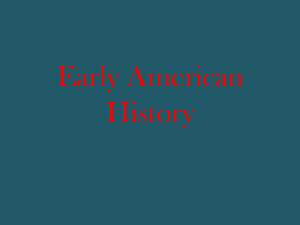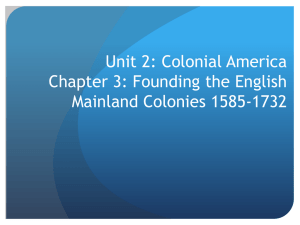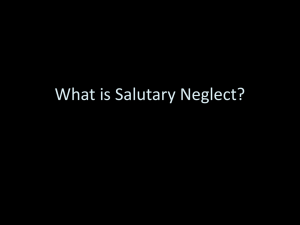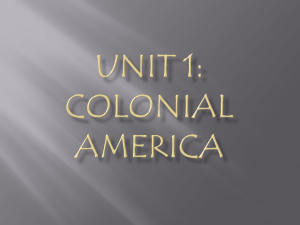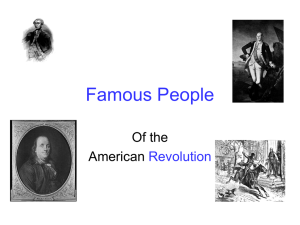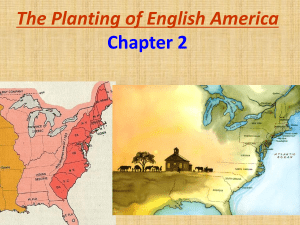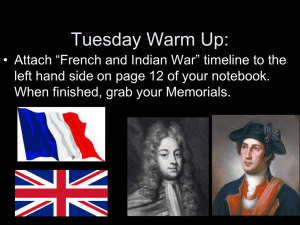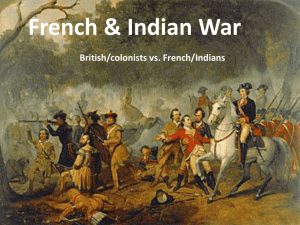European Conquest and Colonization
advertisement
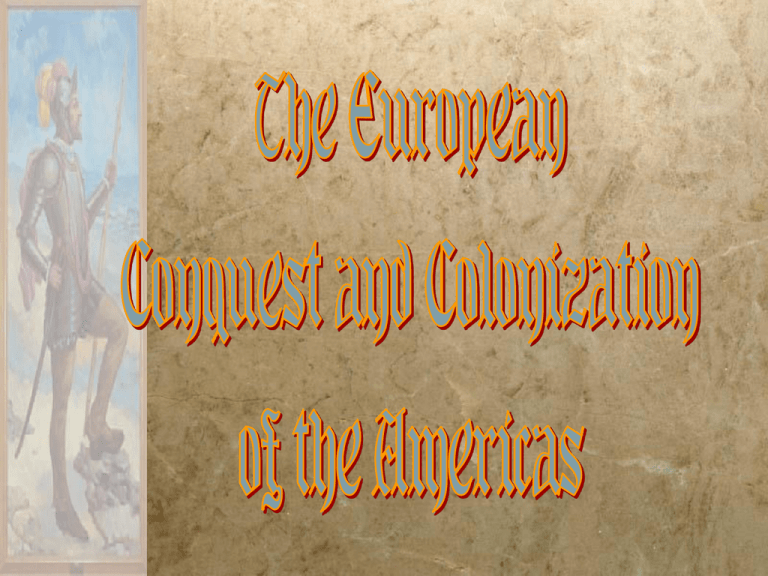
Five Nations started colonies in the New World § Spain – in South, Central and North America § Portugal – in Brazil § France – In Canada § Great Britain – along the East Coast of North America § The Dutch – On Long Island European Empires in the Americas Cycle of Conquest & Colonization Explore rs Official European Colony! Ferdinand Magellan & the First Circumnavigation of the World: Early 16c European Explorations Christófo Colón [1451-1506] Columbus’ Four Voyages T he Treaty of Tordesillas, 1494 & T he Pope’s Line of Demarcation T he First Spanish Conquests: T he Aztecs vs. Fernando Cortes Montezuma II T he Death of Montezuma II Mexico Surrenders to Cortés T he First Spanish Conquests: T he Incas vs. Francisco Pizarro Atahualpa Father Bartolomé de Las Casas New Laws --> 1542 The “Columbian Exchange” v Squash v Avocado v Peppers v Sweet Potatoes v Turkey v Pumpkin v Tobacco v Quinine v Cocoa v Pineapple v Cassava v POTATO v Peanut v TOMATO v Vanilla v MAIZE v Syphilis v Trinkets v Liquor v GUNS v Olive v COFFEE BEAN v Banana v Rice v Onion v Turnip v Honeybee v Barley v Grape v Peach v SUGAR CANE v Oats v Citrus Fruits v Pear v Wheat v HORSE v Cattle v Sheep v Pigs v Smallpox v Flu v Typhus v Measles v Malaria v Diptheria v Whooping Cough Docs. 1- 4 The Spanish Gain land and riches §Gain converts (Catholic) §Conquered and destroyed native cultures (Encomeinda system) Spain in the New World §Motivated by the 3 G’s §God, Glory and Gold §Destroyed native culture §Encomienda system Mercantilism §Economic activity should enhance power of the state (more gold and silver). Mercantilism An economic policy of the major trading nations from the 16th to the 18th cent… …based on the premise that national wealth and power were best served by increasing exports and collecting precious metals in return. State action, an essential feature of the mercantile system… …used to accomplish its purposes-to sell more than it bought to accumulate bullion and raw materials. Under a mercantilist policy, a government exercised much control over economic life by… regulating production, encouraging foreign trade, levying duties on imports to gain revenue, making treaties to obtain exclusive trading privileges, and exploiting the commerce of the colonies. Mercantilism §Favorable balance of trade – Spanish try to control access to wealth §Mining (gold and silver) §Control commerce. Fight for control §Spanish crown, colonists, and church fight for Indian cheap labor. Foundation of economy – Indian labor. §Indian slavery and coercion – Indians paid tribute of gold and silver and worked for almost nothing or nothing. Encomienda §An assignment of Indians who were to serve the Spanish grantee (colonist) with tribute and labor…Indian slavery! Encomienda System = Feudal System § Headed by the Viceroy – a noble § Social hierarchy based on race §Peninsulares §Creoles §Mestizos §Mulattoes § Presidio – fort used to defend the mission – castle Haciendas §As the encomienda system began to fail colonists created plantations called Haciendas – moved towards capitalism §Tribute was no longer given §Slavery still existed The Congregacion §Churches attempt to control Indians §Placed Indians on reservations The Missions §Once Indians were concentrated, Missions were established to convert and westernize the natives §Church schools The Influence of the Colonial Catholic Church Guadalajara Cathedral Spanish Mission Our Lady of Guadalupe Spanish Colonial Class System Peninsulares Creoles Mestizos Native Indians Mulattos Black Slaves Treasures from the Americas! English Migration: 1610-1660 The English Transplantations: Motives for Settlement § Commercial §European belief in mercantilism §Find wealth or escape poverty (enclosure movement) § Religious §Puritans wanted to escape persecution §Establish religious communities The English §Commercial ventures ($) §Joint Stock Companies Must Know §Religious freedom (Protestants) §Friendly at first – later fought natives for land English Colonization The Charter of the Virginia Company: Guaranteed to colonists the same rights as Englishmen as if they had stayed in England. This provision was incorporated into future colonists’ documents. Colonists felt that, even in the Americas, they had the rights of Englishmen! The English Transplantations: Jamestown § The first permanent English settlement §Colonists were “gentlemen” §Expected to find gold § Poor location and management §Located for defense §Smith saved colony from disaster Captain John Smith: The Right Man for the Job?? There was no talk…but dig gold, wash gold, refine gold, load gold… Jamestown §Their neighbors were the Powhattan Indians §Pocahontas §The English mistreated the Indians and used force to get what they wanted. This angered the Indians who refused to help the settlers Jamestown §Jamestown nearly failed due to lack of supplies, poor weather and poor location 60 miles up the James River in a swampy area (Defense). High Mortality Rates The “Starving Time”: 1607: 104 colonists By spring, 1608: 38 survived 1609: 300 more immigrants By spring, 1610: 60 survived 1610 – 1624: 10,000 immigrants 1624 population: 1,200 Adult life expectancy: 40 years Death of children before age 5: 80% John Rolfe What finally made the colony prosperous?? What saved Jamestown? Must Know §Tobacco was grown and the colony began to make a profit. Brought more settlers and $ Tobacco Plant Virginia’s gold and silver. -- John Rolfe, 1612 English Tobacco Label First Africans arrived in Jamestown in 1619. Their status was not clear perhaps slaves, perhaps indentured servants. Slavery not that important until the end of the 17c. Virginia: “Child of Tobacco” Tobacco’s effect on Virginia’s economy: Vital role in putting VA on a firm economic footing. Ruinous to soil when continuously planted. Chained VA’s economy to a single crop. Tobacco promoted the use of the plantation system. Need for cheap, abundant labor. Early Colonial Tobacco 1618 — Virginia produces 20,000 pounds of tobacco. 1622 — Despite losing nearly one-third of its colonists in an Indian attack, Virginia produces 60,000 pounds of tobacco. 1627 — Virginia produces 500,000 pounds of tobacco. 1629 — Virginia produces 1,500,000 pounds of tobacco. Tobacco Prices: 1618-1710 Why did tobacco prices decline so precipitously? Why was 1619 a pivotal year for the Chesapeake settlement? Virginia House of Burgesses Growing Political Power The House of Burgesses established in 1619 & began to assume the role of the House of Commons in England Control over finances, militia, etc. By the end of the 17c, H of B was able to initiate legislation. A Council appointed by royal governor Mainly leading planters. Functions like House of Lords. High death rates ensured rapid turnover of members. Indentured Servitude Headright System The English Transplantations: Plymouth § Pilgrims §Separatists looking for religious freedom § Created Mayflower Compact §Government gets power from the people § Relations with the natives New England §Pilgrims (1620) were religious dissenters who wanted to separate from the Church of England. They faced fines, imprisonment or death in England for practicing their religion §Came for Religious Freedom New England § The Pilgrims were headed for Virginia, but were blown off course in a storm, and ended up in Must Massachusetts Know § Created the Mayflower Compact – a document that says the government gets its power from the people Must Know The English Transplantations: Massachusetts Bay §Puritans §Wanted to purify church §Faced persecution §“City on a hill” §A religious model for the world §Intolerant of dissent New England § Puritans (1630) also sought religious Must freedom Know § Wanted to create Cities on a hill – religious cities that would serve as a model for others Must § Covenant Communities Know §intolerant of dissent New England § Puritans were governed by the male members of the church Must Know § Town meetings – discussions about church rules that eventually became legislative assemblies France in the New World §Commercial Incentives §Fishing and fur trade §Northwest Passage §Adopted native customs §Married into families §Learned language The French Fishing, Fur Trapping §Looking for the Northwest Passage §Gain converts (Catholic) §Traded w/ natives (partners) §Married Native American women Trans-Atlantic Slave Trade Slave Ship “Coffin” Position Below Deck A frican Captives T hrown Overboard Slaves Working in a Brazilian Sugar Mill Sacrifice of the First-Born by T heodore de Bry
